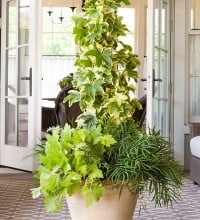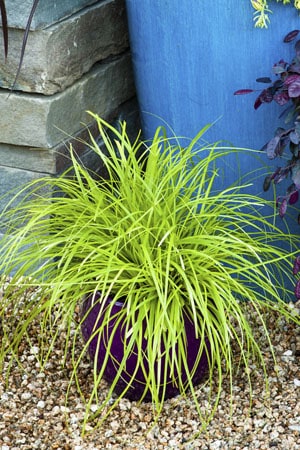By Karen Chapman of Le jardinet
Resembling a giant ivy, this is in fact a well behaved but flamboyant hybrid between English ivy (Hedera helix) and Japanese aralia (Fatsia japonica) that offers glossy evergreen leaves with a bold creamy-yellow variegation that gains red tints in cold weather , yet does not climb or became invasive.
Pruning will encourage this fast growing shrub to develop side branches, resulting in a more compact habit. However its natural tendency is to shoot for the stars, so adding a support upon which it can be trained will offer additional possibilities as a tall container centerpiece or as an evergreen screen.
Fatshedera is usually evergreen when winter temperatures remain above 5’F . Below that temperature this shrub may die to the ground but usually regrows from the crown in spring in areas where it is root hardy.
With so many possible uses, how will you showcase ‘Angyo Star’ Fatshedera in your garden? Here are two ideas to get you started.
Four Season Privacy Screen
Do you need to hide next doors trash cans? Or create more privacy for your patio? It can be a challenge to block your neighbor’s view without appearing un-neighborly. Problem solved when you create an attractive, colorful screen that you can both enjoy.
Rather than erecting a fence, install a lattice-style trellis onto which you can train one or more ‘Angyo Star’ shrubs, gently easing the branches sideways and tying them in with soft twine. For variety you could alternate these with Yuletide camellia (Camellia sasanqua ‘Yuletide). In winter the red camellia flowers with their boss of yellow stamens will create a colorful highlight for the Holidays while the deep green camellia foliage will enhance the variegation of the fatshedera year round.
A finishing touch would be a mass planting of EverColor® ‘Everillo’ Carex at the base of the shrubs. This golden grass-like evergreen would introduce fine texture while echoing the yellow tones of the shrubs.
Woodland Wake Up
Add the ‘wow factor’ to your woodland by using ‘Angyo Star’ in combination with hostas, ferns and Japanese maples. The deeply quilted, cupped, blue foliage of Love Pat hosta (Hosta ‘Love Pat’) and the delicate western maidenhair fern (Adiantum aleuticum) would make excellent partners for this bold shrub, forming an exciting textual tapestry for many months. Contrast could be introduced by including darker leaved Japanese maples such as Rhode Island Red (Acer palmatum Rhode Island Red).
When the perennials become dormant and maples drop their leaves the woodland garden typically goes into a long winter snooze. Change all that with the inclusion of the bold, colorful and evergreen foliage of the fatshedera . You’ll find yourself enjoying your winter woodland in a new way.




